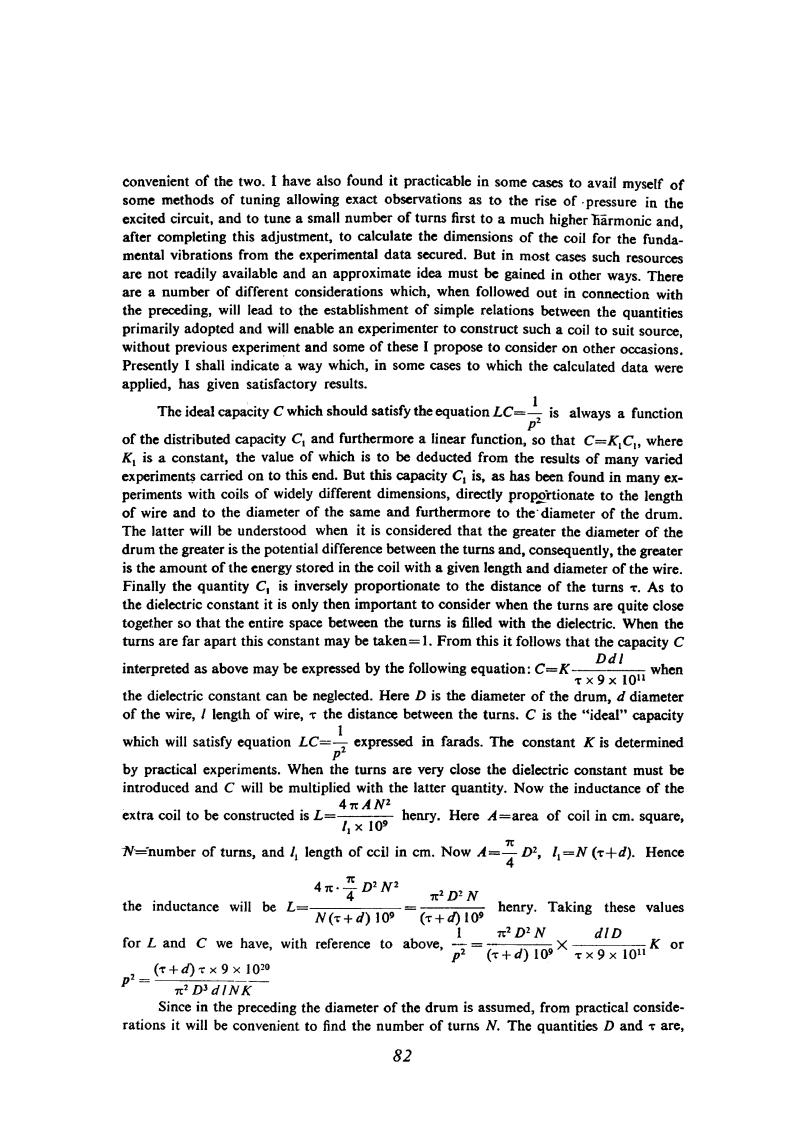
Nikola Tesla Books
convenient of the two. I have also found it practicable in some cases to avail myself of some methods of tuning allowing exact observations as to the rise of pressure in the excited circuit, and to tune a small number of turns first to a much higher harmonic and, after completing this adjustment, to calculate the dimensions of the coil for the fundamental vibrations from the experimental data secured. But in most cases such resources are not readily available and an approximate idea must be gained in other ways. There are a number of different considerations which, when followed out in connection with the preceding, will lead to the establishment of simple relations between the quantities primarily adopted and will enable an experimenter to construct such a coil to suit source, without previous experiment and some of these I propose to consider on other occasions. Presently I shall indicate a way which, in some cases to which the calculated data were applied, has given satisfactory results.
The ideal capacity C which should satisfy the equation LC = $! {1 \over p^{2}} $! is always a function of the distributed capacity C1 and furthermore a linear function, so that C = K1C1, where K1 is a constant, the value of which is to be deducted from the results of many varied experiments carried on to this end. But this capacity C1 is, as has been found in many experiments with coils of widely different dimensions, directly proportionate to the length of wire and to the diameter of the same and furthermore to the diameter of the drum. The latter will be understood when it is considered that the greater the diameter of the drum the greater is the potential difference between the turns and, consequently, the greater is the amount of the energy stored in the coil with a given length and diameter of the wire. Finally the quantity C1 is inversely proportionate to the distance of the turns Ï. As to the dielectric constant it is only then important to consider when the turns are quite close together so that the entire space between the turns is filled with the dielectric. When the turns are far apart this constant may be taken = 1. From this it follows that the capacity C interpreted as above may be expressed by the following equation: $! {C = K {Ddl \over {Ï \times 9 \times 10^{11}}}} $! when the dielectric constant can be neglected. Here D is the diameter of the drum, d diameter of the wire, l length of wire, Ï the distance between the turns. C is the âidealâ capacity which will satisfy equation LC = $! {1 \over p^{2}} $! expressed in farads. The constant K is determined by practical experiments. When the turns are very close the dielectric constant must be introduced and C will be multiplied with the latter quantity. Now the inductance of the extra coil to be constructed is L = $! {{4 \pi A N^{2}} \over {1_{1} \times 10^{9}}} $! henry. Here A = area of coil in cm. square, N = number of turns, and l1 length of coil in cm. Now A = $! {{\pi \over 4} D^{2}} $!, l1 = $! {N (Ï+d) } $!. Hence the inductance will be L = $! {} $! = $! {} $! henry. Taking these values for L and C we have, with reference to above, $! {1 \over p^{2}} $! = $! {{{\pi^{2} D^{2} N} \over {(Ï + d) 10^{9}}} \times {{dlD} \over {Ï \times 9 \times 10^{11}}}K} $! or $! p^{2} = {{(Ï + d) Ï \times 9 \times 10^{20}} \over {\pi^{2} D^{3} d l N K}} $!
Since in the preceding the diameter of the drum is assumed, from practical considerations it will be convenient to find the number of turns N. The quantities D and Ï are,
82
July 11
By introducing the additional coil in the oscillator circuit Tesla achieved one modification of his oscillator with resonant transformer. by which means he obtained higher voltages. When these voltages exceeded several hundred thousand volts, he had to carefully lay out the elements, and choose very good insulators. Here the instructions are given how to make the terminals in order to obtain longest and most powerful spark along with delaying the flashover to the instant when maximum voltage is reached (or some desired voltage). He suggests the procedure which enables the voltage measurement by means of metal spheres of various radii. He discusses the disadvantages of this method because the spheres introduce additional capacitance which disturbs the resonance conditions in high frequency circuits.
Tesla considers the additional coil extraordinarily suitable for the achievement of "any" voltage. He gives two wiring schematics of this coil for an oscillator high frequency transformer. He claims that with this coil. considerably higher voltages are achieved than with the secondary in poorer linkage with the primary.
Tesla explains this with the fact that the additional coil is not in an inductive link with the primary, and there is no such reaction in the primary which would dampen the oscillation. He doesn't explain how he imagines this coil to be excited and not to react on the primary transformer secondary to which it is directly connected.
The additional coil description is very detailed. Tesla's wealthy experience in coil design is obvious in its full extent. At the end of his considerations he gives the equation for determination of the number of turns for the additional coil on the basis of operation frequency, wire diameter, separation of windings, and a constant which he determines on the basis of experimental results. He checks the equation on one example and obtains a result very close to the experimental results.

